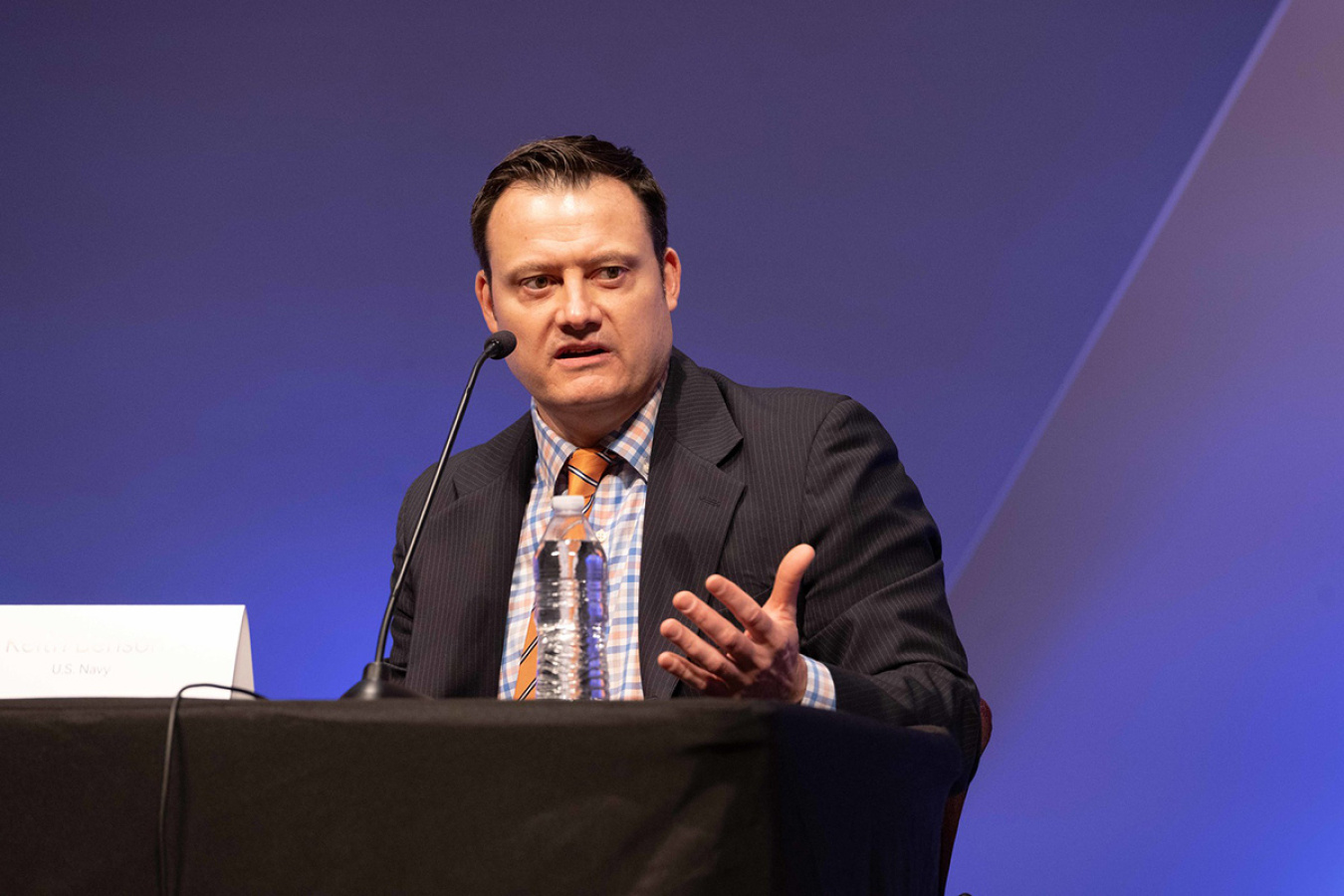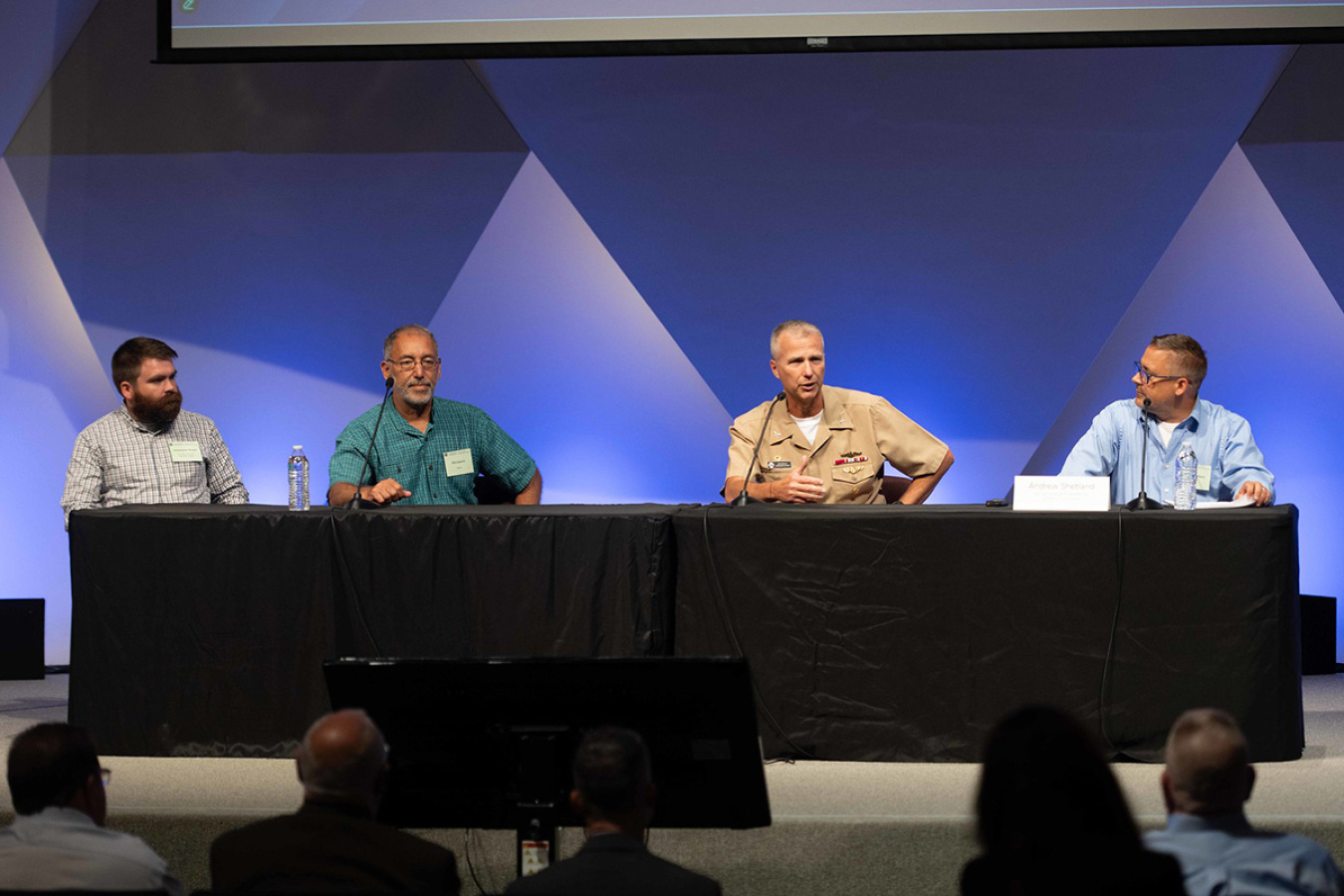Speakers discuss lessons learned and best practices and identify replicable solutions that can be applied across the federal government.
Federal Energy Management Program
September 24, 2025The federal government, as the nation's single largest energy consumer, plays a crucial role in responsible resource stewardship. Achieving significant energy and water savings requires dedicated individuals and effective strategies.
Before the Federal Energy and Water Management Awards (FEWMA) ceremony on August 7, 2025, awardees convened at the National Academy of Sciences for the Award Winning Champions Shared Lessons Learned Forum. FEMP Federal Engagement Supervisor Creshona Armwood kicked off a five-part panel discussion highlighting key best practices and replicable solutions for federal agencies.
"Great success in this field requires knowledge, skills, abilities, innovation, and resourcefulness," Armwood said, acknowledging the extraordinary results the panelists delivered despite the challenges they faced. "What sets today's speakers apart is that they have found replicable pathways to success, and they are here to share."
Throughout the event, several high-level themes emerged, connecting the dots between the lessons the award-winning speakers shared during their sessions. Given these awardees' mission-critical work stewarding federal resources and advancing agency missions, other federal employees and agencies stand to benefit from these overarching lessons.
Lesson 1: Secure Diverse Funding and Build Strong Teams
A recurring theme from the awardees was the challenge of limited funding.
Keith Benson, director of energy at Navy Shore Type-Command, Commander, Navy Installations Command (CNIC), highlighted the strategic importance of leveraging federal, state, and private partnerships, alongside creative acquisition methods. He cited examples like reinvesting energy cost savings back into installations through existing authorities.
Benson also stressed the need for a comprehensive approach that extends beyond immediate facility boundaries, fostering collaboration with external partners like utility providers.
Programs within the energy space are consistently under-resourced, Benson said. "There is never enough funding to get to the end state. There's a common vision. There's a common set of goals. And then the challenge sometimes is how do you get the resourcing to align…to ensure mission success?"
Among the examples he cited were a cooperative research and development agreement between CNIC and the Naval Postgraduate School and utilizing some of the authorities under 10 U.S.C. 2912, a statute that allows the U.S. Department of Defense to reinvest energy cost savings, including those achieved through energy savings contracts.
"Through the hard work of energy managers and utility managers and base commanding officers and public works officers, we’re reinvesting those dollars back into those installations across each of the regions for the benefit of the Navy and the Department of Defense and our national security," said Benson, with a nod to the importance of putting together highly effective teams.
"Everybody brings value to the table in certain ways," Benson said, highlighting CNIC's partnerships with his copresenter Guy Warner's company, Pareto Energy, and utility provider Southern California Edison. "When we talk about energy and resilience, sometimes we only focus inside of the grid or inside the installation. And I would argue we need to have a whole-of-project approach—inside and outside the fence line."
Lesson 2: Cultivate Widespread Buy-In
While tools, partnerships, and teams are essential for projects execution, getting initiatives off the ground—and maintaining momentum—requires buy-in. For several panelists, securing buy-in was a process of overcoming multiple hurdles, including resistance to change.
Career Exceptional Service awardee Erin Hope of Bonneville Power Administration shared his experience with skepticism toward new technologies. "Part of resiliency is reliability," Hope said. "I've found over the years that one of the biggest challenges is convincing people to change…to adopt a new technology that might be more efficient and consider it just as reliable." His lesson was to persistently "prove the technology" despite initial doubts.
Panelists Gary Jackson and Craig Frank recounted overcoming the hesitancy of senior leadership in the early stages of their Energy Security and Resiliency Infrastructure project at Marine Corps Air Station (MCAS) Cherry Point.
"Selling senior leadership is obviously one of the first major tasks," said Jackson. "So, I would recommend you bring the comptroller on board very early in the process to make sure they understand the financing, where the money is going to come from, and how it's—theoretically, and we know it doesn’t happen completely—a net zero cost to the base."
As pivotal as allaying concerns around the MCAS Cherry Point project's cost and duration was providing assurance the base was getting right the energy conservation measures from the utility or energy services companies.
"When a utility or ESCO comes in, a lot of times they're looking for what’s going to be quick and easy," said Frank. "Getting the ECMs to be what the base needed was really critical, as opposed to what was going to pan out best for the ESCO and the utility."
During the Q&A that followed, the audience asked for pointers on getting leadership committed to a project. Frank said demonstrating that projects align with resilience goals was key at MCAS Cherry Point because readiness is central to the Marine Corps mission.
In remarks made during an audience Q&A session, Captain Ken Curtain, commanding officer of Naval Submarine Base New London, captured the essence of securing leadership buy-in: "If you want to get me on board, sell me on the mission impact, but not just that. Tell me the risks of not doing it. And then show me how what you want to do is going to mitigate or eliminate those risks so I can continue to execute the mission."
Lesson #3: Prioritize Training and Cultivate Institutional Knowledge
Panelists frequently cited challenges such as labor shortages and the potential loss of institutional knowledge, underscoring the critical need to prepare for both to ensure project sustainability.
After completing the islanded microgrid project at Naval Submarine Base New London, panelist Andrew Shetland realized the importance of planning for maintenance throughout a project's life cycle, particularly given staffing changes. His team subsequently focused on documenting operational requirements and cross-training competent employees to ensure continuity.
Shetland's team "did our due diligence to document the things that were required for continuous operations, and to put in place competent, capable employees who had some cross-training and overlap with us before we left," he said.
For Erin Hope, building institutional knowledge is a continuous process. He said he makes it a priority to train interns and junior staff, ensuring they have opportunities to work with senior engineers. "I give them the chance to work with senior engineers. I also give the senior engineers a chance to spend the time to teach them," he said. "I make it a priority to say, 'I want 10% of your time cross-training these junior staff. Teach them what you know.'"
Lesson #4: Persevere, Knowing Lessons Learned Pay Off in the Long Run
Building on Hope's remarks about the process of building institutional knowledge, his fellow Career Exceptional Service awardee Melanie Johnson capped off the forum with a retrospective example.
Johnson's recap of her 17-year stint developing and implementing microgrids at military bases served as a lesson in itself. In reflecting on how the insights gained in the process have informed microgrid deployment, she illustrated the inherent value of institutional knowledge built through trial and error—and how that compounds over time.
Today, Johnson said, she spends roughly half her time developing and implementing microgrids at installations while dedicating the rest to anticipating problems those bases will face in the future and figuring out how to solve them.
But getting to this point took perseverance and a firm commitment to the long-term goal of establishing a multilayered, redundant, and strategic approach to energy resilience at U.S. military bases.
"When I first onboarded at CERL [Construction Engineering Research Laboratory]…in 2008, we'd just had our first microgrid research program turned down," she said, describing how the prevailing notion that "distributed generation is where it's at" drove the initial decision to continue focusing efforts there.
"And then we had superstorm, Sandy," she said, recalling how several bases in the Northeast that had invested heavily in solar photovoltaics still lost power. "That was the moment that crystallized for everyone that…we have to do something more to make those resources contribute energy resilience."
But through the successive projects that followed, she and her team learned from multiple pitfalls and setbacks—and in the process, identified critical gaps.
At Joint Base Pearl Harbor Hickam, they installed a microgrid for a wastewater treatment plant, learning that "you could go on business trips to Hawaii and only have bad smells," she joked.
At Fort Carson, they learned about the trade-offs between charry-picking loads and thinking strategically about what generation resources to use. And at Fort Smith, where they turned a whole base into a microgrid for the first time, they learned about dealing with permitting on bases that had multiple tenants with diverse priorities.
The lessons culled from the "research and development, technology demonstration, proof-of-concept microgrid era" are informing today’s "tech transfer era," Johnson said, acknowledging the audience members who are now implementing and building on the lessons of the past. "You guys are out there building these microgrids and learning even more about how to get them done with your personnel, your workspace, your leadership."
Noting that in the Army alone there are 70 projects in development now, Johnson said the situation remains fluid, as installations are constantly having additional demands placed on their infrastructure, and their loads are continually increasing.
To ensure existing and future microgrids can continue to meet installations' evolving needs, Johnson highlighted the need to move beyond traditional planning methods, which relied on historical data. Going forward, she said, microgrid projects will rely on real-time data and analytics, not only to assist installations with planning but also to also enable utilities to respond to changes in demand automatically.
Getting there will require improved connectivity with utility partners, fault-tolerant microgrids, and increased integration among installation control systems, Johnson said—insights current microgrid planners stand to benefit from as they develop forward-thinking solutions.
A Master Class in Dedication
Declaring the forum "a master class," FEMP Director Mary Sotos commended the awardees for showcasing the qualities and strategies needed to make projects, programs, and missions successful. She highlighted their ability not only to develop expertise but also to "build teams that can foster that and replicate it across the government."
"You had to get creative to overcome hurdles and to sustain interest and enthusiasm and dedication to these projects for long periods of time," she said. That's not something that you can easily find in a technical manual about how to do things. That's inspiration. That's dedication. That’s something that you all have, I think, inspired us to bring to our work as well."
The call for 2025 FEWMA nominations opens soon. Stay tuned for more details!




